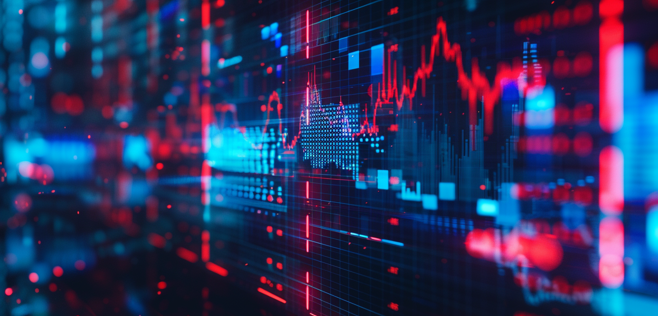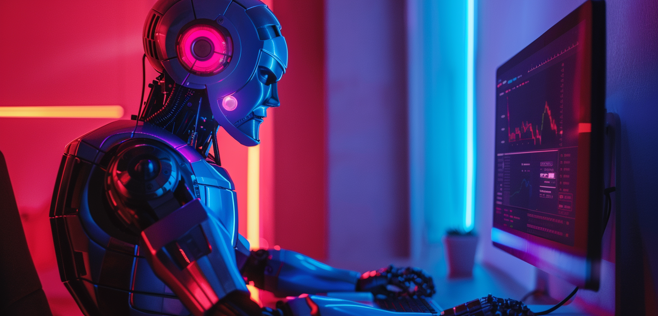Published 25 Jun 2025
How AI Identifies Buy and Sell Signals Without Indicators

AI doesn’t rely on moving averages or traditional indicators to find trading signals. It examines raw market data like price movement, trading volume, volatility, and structure. Then, it identifies recurring patterns appearing over time.
Here is how it does that:
-
Pattern recognition: AI examines charts to find familiar formations and actions, like breakouts, wedges, or double tops. It has the ability to catch incomplete or uneven patterns that still carry importance, unlike what humans would notice.
-
Price and volume connection: It studies the relationship between price and volume movements. For instance, a flat market with a sharp increase in volume might indicate accumulation, which could hint at a chance to enter.
-
Behavioral modeling: AI studies how traders act under certain situations such as hesitation at resistance or FOMO buying. It observes these patterns as they happen to identify trading behaviors in real time.
-
Learning from past data: Instead of following fixed rules, AI uses thousands of previous examples to learn. It notices how specific movements can result in breakouts, reversals, or steady trends. It then uses that understanding to analyze new charts in real time.
The real strength of this lies in its speed and ability to work across many markets at once. AI doesn’t pause to wait for confirmation. It responds to small changes it detects, often catching shifts before traditional tools even respond.
What AI Catches That People Often Miss
Even skilled traders sometimes miss key signals. The human mind looks for clear patterns, familiar setups, or obvious levels. But markets don’t always behave in such neat and predictable ways.
AI doesn’t face those limits.
It looks for patterns that humans can’t spot. These could be partial setups, tiny movements, or uncommon structures that still provide useful hints. Here’s what AI can notice while most traders might overlook:
-
Flawed patterns: A wedge that skips some points or a double top with uneven highs. People might dismiss them, but AI recognizes the signal.
-
Unusual volume spikes: AI identifies strange volume changes at certain price levels. This can reveal things like hidden big trades, trap zones, or accumulation.
-
Grouped behaviors: Instead of noticing a single candle or level, AI studies a whole sequence of moves. Hesitation, fakeouts, or volume drops get turned into meaningful clues.
-
Structural changes: AI monitors shifts in market structure over time. It observes more than just support and resistance. It keeps track of how the market moves every minute.
This pattern identification goes beyond simple alerts like “indicator says buy.” AI interprets what’s unfolding in the market at this moment. This real-time analysis gives AI a distinct advantage.

Examples of AI-Generated Buy/Sell Signals That Don’t Use Indicators
AI doesn’t rely on traditional tools like moving average crossovers or identifying overbought zones. It creates signals by analyzing how the market behaves in the moment.
Check out some examples of how this plays out:
- “Signs point to short-term weakness: low volume after a failed breakout.”
The system observes that a recent attempt to break higher lacked strong buying activity. This hints at a likely reversal due to a possible loss of momentum.
- “Entry opportunity: tight range with stealthy buying action.”
The AI detects a narrow price range combined with calm conditions. Sudden bursts in buy volume suggest that big players might be accumulating.
- “Breakout watch: price compressing with sellers stepping back.”
The system focuses on more than just patterns. It notices reduced sell activity through order flow data signaling waning pressure from sellers.
AI detects patterns by analyzing data. It identifies volume changes, sequence trends, and micro-structures rather than relying on standard indicators.
On top of this, AI offers more than just the signal itself. It provides the reasoning behind potential moves shedding light on why something might shift instead of stating that it could.
This leads to sharper decision-making, well-timed strategies, and fewer incorrect triggers, which is valuable in volatile and fast-moving markets.
Benefits of Using AI Signals Without Traditional Indicators
Relying on no indicators at all may seem risky at first. However, AI doesn’t just make it feasible — it transforms it into a strategy with tremendous potential.
Here’s how AI-generated insights without conventional tools can give traders a real advantage:
-
Quick responses: Instead of relying on lagging indicators to confirm trends, AI takes action as soon as live data starts showing patterns. It doesn’t wait for things to be formed.
-
Clearer signals, less chaos: Standard indicators often send mixed or slow updates. AI cuts through the confusion by zeroing in on real-time market behavior.
-
Flexibility: AI handles changing market conditions like trends, ranges, or high volatility without needing new tools. It trades different assets and setups without requiring manual adjustments.
-
Ability to scale: AI can track dozens of charts at the same time in real time. Human traders cannot keep up with that speed or level of detailed observation.
-
Learning on its own: AI updates itself as things shift. By retraining with fresh data, it keeps getting better over time. Indicators, on the other hand, don’t adapt this way.
AI doesn’t rely on fixed unchanging tools. Instead, it brings flexible trading that reacts to market changes. This approach works well in fast-paced markets like crypto.

Wrapping it up
Many traders depend on indicators to decide when to buy or sell. But indicators are slow to respond and often miss broader trends.
AI takes a different path.
It studies the market itself—price movement, trading volume, patterns, and structure. It spots signals people might miss. No moving averages. No RSI. Just logic, context, and recognizing what’s really happening in the market.
This doesn’t make trading simple. People still need strong strategies, reliable information, and strict guidelines. But it does let traders move away from old and sluggish tools to keep competing.
AI doesn’t make random guesses. It analyzes. And when properly designed, it can identify opportunities faster than older systems can even respond.
Read More




 Get RateX Pro
Get RateX Pro

 06 Jun 2024
06 Jun 2024
